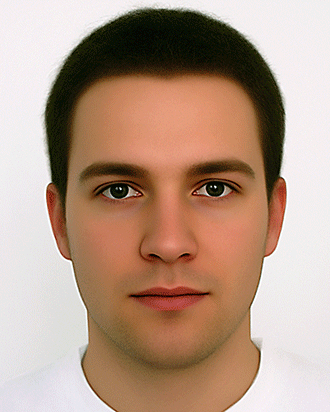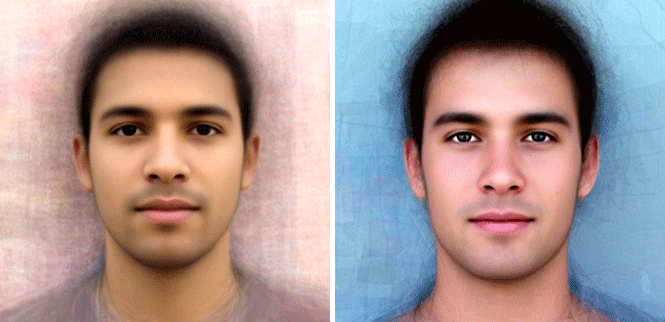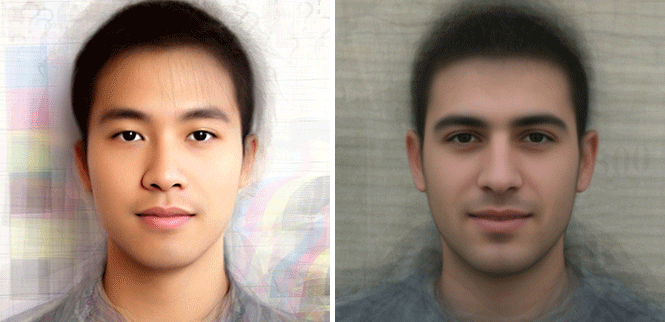My Facial Feminisation Thesis
Part 3:
Prototypes
Before we look at prototypes in more detail it is important to point out that even they are not a perfect way of analysing male and female facial differences and there are various ways for inaccuracies to creep into the creation of prototypes. For example, there is no way to define the degree of forwards or backwards tilt of the head; this is a problem because the features, as seen from the front, change their relative proportions and positions in a 2D image depending on this degree of tilt. For example: the eyebrow position, relative to the eye, will change because the eyes are set further back than the eyebrows so as the head tilts down, the eyebrows seem to get closer to the eyes and vice versa. Similar issues arise with other features. This could be made worse if the person taking the initial photographs, does not take care to set the camera at the same height relative to the face for each shot – if the camera remains static for example, women's heads will tend to be photographed at a slightly different angle from men's because women are, on average, shorter.
On attempt to overcome this is a line called the "Frankfort Plane" which is a horizontal line drawn from the top of the ear canal to the bottom of the eye socket. This is supposed to give a line by which you can judge the angle of tilt of the skull. But it is not reliable because it depends on 2 points of reference and it will not work for anyone who is outside the average positioning for either or both of these points. This may be most people.
Once we have created the prototypes we need to compare them and here we face another problem - the 2 faces are different sizes. This is partly because men and women are different sizes but this could also be emphasised by inconsistencies and errors in the averaging process. So, we need to balance the sizes of the prototypes so that they are equivalent to each other.
In order to do this we need a base measurement – a measurement that is consistent between both faces. But what should we use? If, for example, we match the distance between the top of the head and the bottom of the chin on both faces, it doesn't show us that the male chin is proportionately taller than the female – they are both end up the same height. Similar problems arise with several other ways of matching the images - in fact there is no fool-proof base measurement but the standard approach is to match the distance between the pupils on both prototypes so that the pupils are in exactly the same place on both images. This actually works well for our purposes because you can't surgically alter the distance between the eyes so if you imagine that the prototypes represent a face before and after FFS, they would booth have exactly the same eye position. Resizing them according to inter pupil distance also anchors the face in a way that seems intuitively right and many of the changes we then see as we move from one face to the other conform to the established scientific research like the difference in the height of the lower third of the face. We can actually judge the quality of a prototype to some extent by how well it confirms to the established scientific research.
There are many examples of averaged faces that you can see on the internet for example on the Beauty Check website. I am very grateful to Dr. Martin Gruendl for permission to use those images here:

These prototypes are of the more unusual type where the top edge of the female's eyebrows are slightly higher than the male's (in most prototypes the eyebrows are at the same height). Another website: faceresearch.org is more specifically looking at gender. But one of the most interesting sets of prototypes available were created by Mike Mike for the website: The Face of Tomorrow. Mike visits cities around the world; photographs 100 completely random faces and then creates prototypes from them to explore issues of identity. The site is fascinating and I am very grateful to Mike for allowing me to reproduce some of the images here:


I decided to do one of these studies myself so that I could be sure it was set up for the particular purposes of FFS. To create the prototypes I downloaded a large number of faces from The Productive Ageing Laboratory at the University of Texas at Dallas. I would like to thank them very much for granting me access to the database and for permission to use the images.
Almost all of the averaged faces you find in other studies are frontal views of faces so one of the things I wanted to do was to create averaged profile images too. This is a very important view in FFS because it is the only view in which you can properly assess certain key attributes like the degree of brow bossing, chin projection or the shape of the bridge of the nose – these just don't show very well from the front in 2D images. It would have been good to have access to ¾ profiles too but they were not available.
From the database I was able to assemble 16 male frontals, 16 female frontals, 16 male profiles and 16 female profiles. One problem with creating prototypes from a completely random selection of faces is that your results can be skewed by faces which are a long way outside the norm. For example, if you averaged 4 female faces but one of those faces, by chance had an unusually large nose, the prototype you create would have at least a slightly bigger nose than the average woman. The more faces you use, the more these oddities are filtered out. However, I was able to narrow the selection down to 16 faces from each group by choosing mostly faces that were already fairly average and avoiding faces with clearly unusual features.
Other things to consider are that I chose all young adults (between about 25 and 45). This is because I wanted to use faces that had fully developed their adult features but had not yet been affected by ageing - I felt that the ageing of the features was a separate issue and would complicate the results. I also avoided subjects who were overweight. Again, extremes of weight would distort the result and limit the usefulness of the study – excess fat feminises the cheeks in males and hides the jawline in both sexes. Finally, all the subjects are white. There 2 reasons I went for white faces: one is simply that there was a larger selection to chose from in the database but also that the majority of people seeking FFS at the moment seem to be white. I base the belief that the majority of FFS patients are white on the percentage of my clients that are and the percentage of clients referred to me by surgeons who are. Fortunately, the same principles of male and female facial differences apply across all ethnic groups but please see my page on ethnic variations for more on this.
Thanks to the Face of Tomorrow site we can see some prototypes with higher proportions of non white ethnicities and I have included some in the examples above (though he doesn't choose faces according to ethnicity – it simply happens that a random selection in a particular city will produce a large number of one particular ethnicity).
In the next part we will look at the prototypes I have created and consider what they, and other studies tell us about the differences between male and female faces.
Please use the links below to navigate around the thesis:
Part 2: The Established Research
Part 4: Sexual Dimorphism of the Face Feature by Feature
Part 6: Female Neoteny and Feminisation as a Subtractive Process
Part 7: Objective and Subjective Femininity
Part 8: How Feminine is Feminine Enough?
Part 10: The Man in the Mirror/Self Perception